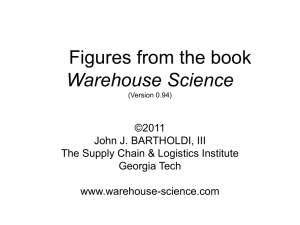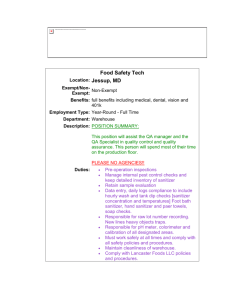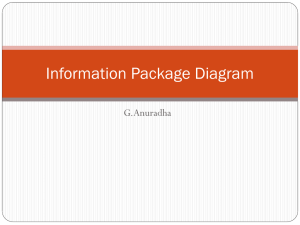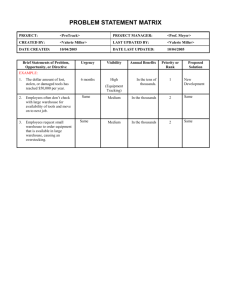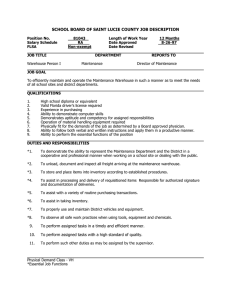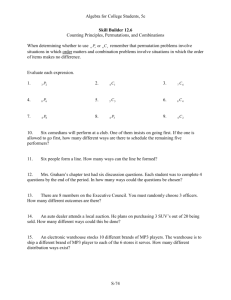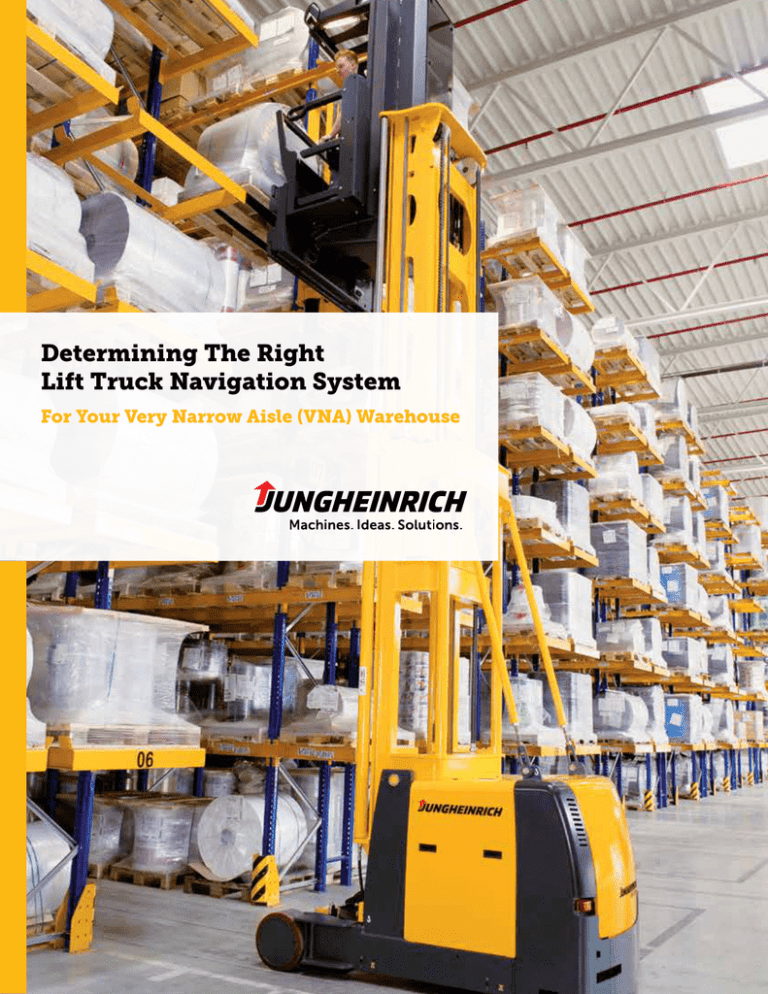
Determining The Right
Lift Truck Navigation System
For Your Very Narrow Aisle (VNA) Warehouse
Determining The Right Lift Truck
Navigation System
For Your Very Narrow Aisle (VNA) Warehouse
Today’s pressures on warehouse managers are endless and unrelenting – to increase productivity,
improve picking accuracy and drive down costs. Rather than fading away, these demands grow
more intense each year, and many businesses continue to explore new ways to overcome these
challenges in their operations.
While factors such as warehouse layout, aisle size and order
picking methods impact overall productivity and order picking
accuracy, the use of lift truck equipment and related navigation
systems also plays a major factor. The purpose of this white
paper is to review existing and new lift truck navigation
technologies and the impact they have on very narrow aisle
warehouse operations today. This paper will also identify key
factors for warehouse managers to consider when evaluating
these systems for their specific applications.
Lift Truck Navigation Options
The warehouse manager has three choices for reaching
destinations in a warehouse:
• Manual systems (operator onboard lift trucks)
• Fully-automated selections, such as Automated Storage /
Retrieval System (AS/RS), unit load or mini load, or Automated
Guided Vehicles (AGV) solutions
• Hybrid (or flexible) alternatives. These are semi-automated
systems that include both current and brand-new navigation
and picking technologies, combined with operator onboard
lift trucks.
Each of these choices has its own unique advantages and
disadvantages:
• Manual systems have been the most flexible and productive,
but generally have the highest labor costs and the lowest
efficiency and accuracy.
• Companies may invest a lot of capital into fully-automated
systems, seeing these as the silver bullet. For the right application,
automation can be a great empowerment, but can also be
capital-intensive, quickly outdated and highly inflexible in
the face of rapid and uncertain change. Sometimes the most
complex and most expensive solution is not the best choice.
• Hybrid Systems, also called “flexible systems” or “semiautomated systems,” can offer the advantages of the other
two with fewer drawbacks.
2
This white paper illustrates a warehouse manager’s options for
semi-automated material handling, especially in Very Narrow
Aisle (VNA) applications. It also focuses on new warehouse
navigation systems that use Radio Frequency Identification (RFID)
transponders to locate and guide VNA lift trucks within the aisles
of a warehouse.
Hybrid Systems: An Overview
Hybrid approaches are built on a Warehouse Navigation System.
Warehouse Navigation uses RFID technology to support a semiautomatic approach to reaching racking locations within the
warehouse.
Transponders, placed in the warehouse floor at specific intervals,
carry information that an RFID reader in the lift truck reads to
identify warehouse aisles, locations and distances with very
precise accuracy – to within .4” or less. Equipped with this
information and a height measuring system, the lift truck knows
exactly the horizontal and vertical movement to most efficiently
accomplish its task.
The lift truck can be programmed to reach specific pallet
positions by selecting the most efficient combination of traveling
and lifting/lowering. This technology, already proven in Europe,
can deliver major efficiency gains, reduce product damage,
improve picking accuracy and increase productivity up to 25%.
Maximum Flexibility, Minimum Maintenance
Flexibility for any changes in the warehouse and low installation
costs are main considerations in developing transponder
technology. In the past, commands to the forklift restricted the
user through such methods as magnets or reflective markers.
However, Warehouse Navigation offers complete freedom.
Transponders are inexpensively installed, and if a rack row
changes in the warehouse aisle, the transponders are simply
and quickly reprogrammed to the new location.
What Navigation Choices Are Available To The Warehouse Manager?
The warehouse manager looking at a Hybrid or semi-automated
system for warehouse navigation has three principal choices:
indoor GPS, 2-D bar code tracking systems and RFID transponders
(a floor-embedded control system).
1.Indoor GPS
• Can use network of ground-based transmitters that
communicate to the lift trucks
• Currently tracks location only
• Has better tracking accuracy than satellite-based GPS systems
• Is capable of being used indoors or outdoors
ONCLUSION: This option has some applications for tracking
C
lift truck location. For collection of lift truck performance data,
further integration of systems is required.
2. 2-D Bar Code Tracking System
• Uses truck-mounted camera and ceiling mounted tiles to
determine lift truck position within the warehouse
• Accurate to within inches
• Advanced integration between the lift truck and the system
can provide travel path information to the lift truck operator
• Installation is expensive due to the quantity of tiles to be
installed at the ceiling level.
CONCLUSION: This type of system is suitable for wide aisle and
VNA applications. However, the required truck-mounted hardware
and ceiling-mounted tiles can make this a high-cost option for
some applications.
3. RFID Transponder System
• The system’s floor-embedded “transponders” communicate
with RFID readers mounted onboard the lift truck to
precisely determine the lift truck location and automatically
adjust truck performance to match location requirements.
• Travel speed, travel direction, lift height, and auxiliary and
ancillary lift truck functions can all be controlled – for
maximum efficiency and productivity.
• These transponder-based systems result in the highest levels
of picking accuracy.
• Highest accuracy allows the retrieval and put away of full
pallets.
• Coupled with Warehouse Management System (WMS)
communications, scanning or operator data entry can be
completely eliminated.
• Warehouse Navigation can only be used within all railguided or wire-guided VNA lift trucks.
• The lift truck can enter an aisle in either direction. Entry into
an incorrect aisle can also be prevented.
• The lift truck operator can always move the truck manually,
retaining the ability to react to the unforeseen.
• All pick up and deposit information is delivered by the WMS
via wireless RF terminals.
CONCLUSION: A Warehouse Navigation System is a proven
alternative for warehouse managers in VNA environments,
especially those interested in increasing productivity and
efficiency in their operation.
3
How An RFID-Based Warehouse Navigation System Works
Here’s how a Warehouse Navigation System, which uses
transponder RFID technology, works to control guided VNA
lift trucks within the aisle of a warehouse. For starters, to use
Warehouse Navigation, a turret truck and/or order picker must
be guided in the aisle by wire or rail. RFID transponders are also
embedded into the floor.
These transponders transmit instructions to the lift truck through
RFID readers on the forklift’s underside. RFID transponders do not
require a direct line of sight. Armed with this flexible system, the
warehouse can track the exact location of each lift truck outfitted
with this technology.
Let’s focus on a specific example:
• The WMS sends an order to the RF terminal on the lift truck,
telling it where the next pallet or case is to be picked up or
put away. The locations are then communicated from the RF
terminal to the lift truck’s controller.
• Using the transponders and sensors on the truck, the lift truck
identifies where it is in the aisle and where it has to go to pick.
All the operator has to do is turn the throttle in the direction
the lift truck has to travel, which is shown on the truck’s
display.
• The lift truck will then drive forward (or backward),
automatically lifting/lowering to the right height and stopping
at the correct pallet location. And, on a turret truck, the forks
would reach out and pick the correct pallet.
• Once the pallet is picked, the lift truck sends a confirmation
back to the WMS and is ready for the next order.
At this point, there is no need to scan either the location or the
pallet, since both are already known by the system. Note that
this elimination of scanning saves valuable seconds and reduces
cycle time, which translates into increased productivity.
4
Possible Travel Paths To Picking Destination
(Diagram A)
36 seconds – common routes
28 seconds – fastest route using Warehouse Navigation
The Most Efficient Travel and Lift Path
One of the fundamentals of a VNA lift truck is that the higher the
truck is, the slower the drive speed. At a height of 60 inches or
less, maximum travel speed is considerably more than at a higher
lift height. At high lift heights, travel speed is vastly reduced. This
basic fact applies to both turret trucks and order pickers. To
improve productivity and number of picks per hour, the operator
needs to get to the location in the most efficient way possible –x
precisely what Warehouse Navigation achieves.
x
The graph above (Diagram A) illustrates three possible travel
paths for a lift truck picking from the floor up to a high pick
location. The first red line (Line 1) assumes the operator travels at
full speed along the floor and then spends time lifting at the end.
The total travel time is 36 seconds. The second red line (Line
2) assumes that the operator lifts and drives at the same time,
which is a more efficient way of traveling. However, the total
travel time is again 36 seconds.
The green line (Line 3) shows the path that Warehouse Navigation
directs, completing the travel and lifting in 28 seconds –the
optimum time to get to the location. This productivity gain
represents a dramatic 29% improvement in one simple motion.
That 29% improvement in this single example points to the kind of
productivity gains that a Warehouse Navigation System is capable
of delivering.
Simplified Decision-Making
The Warehouse Navigation system can also be used to eliminate
the operator’s decision-making regarding travel and lift routes,
thereby delivering a faster and more efficient picking process.
This increased efficiency is extremely important to the operator
(who may be paid per pick), but even more so to the warehouse
manager, who has the daily challenge of maximizing productivity
and reducing costs.
The “Bathtub” Curve
(Diagram B)
Another example:
• The operator begins his process by picking his order at the top
of the rack location. The next pick location is down the aisle
and also at the top of the rack.
• All the operator has to do now is to move the throttle. When
he does, instead of moving directly across, the system directs
the lift truck to drive and lower, because it can move faster at
a lower lift height.
• As it gets closer to the pick location, the truck lifts to reach its
destination with maximum efficiency.
• The Warehouse Navigation System takes the guesswork out of
the process by deciding when to lift, depending on the height
of the pick, and uses the most efficient route to achieve the
designated pick.
This is also an added benefit for those applications that have
seasonal or temporary lift truck operators, as there is no fall-off
in productivity when a new operator starts in the warehouse.
Warehouse Navigation ensures that new operators can operate
the lift trucks as productively as experienced operators and also
helps reduce the risk of product damage.
Conclusions
1.Today’s technological advances allow full integration of the
lift truck fleet into the WMS, creating the greatest efficiency
in product movement.
6. F
lexibility is key. Changing the layout of a warehouse does
not mean re-laying of the transponders. They simply need
reprogramming.
2.Greater positioning accuracy produces reductions in travel,
verification, error correction and throughput times.
7.Net/net: Because the warehouse can move more product in
less time, it can be possible to reduce lift truck fleet size and
number of operators.
3.These competitive advantages produce productivity gains of
up to 25%.
4.These productivity gains are realized regardless of who is
operating the lift truck. Thus, the warehouse will see these
gains even when it has new staff, seasonal employees or
night shift operators.
5.Because the controller stops the lift truck at exactly the
correct position, product does not get damaged from either
incorrect positioning or inexperienced operators.
8.This technology is already proven in Europe, where it is
currently in successful use in hundreds of applications, in
addition to several North American operations. Warehouse
Navigation is efficient, dependable and cost-effective.
9.Improved accuracy, reduced product damage and no loss
of productivity with new, seasonal or temporary employees
– these, in addition to other key benefits, all add up to
increased productivity and a reduction in logistics costs.
10. These new advances in lift truck technology also provide
warehouse managers with added flexibility, in addition to
increased productivity and performance.
These new advances in lift truck technologies mean new solutions for warehouse managers today – in
addition to new opportunities for greater gains in efficiency and productivity. Since each application varies,
warehouse managers should consult with their local dealer or a trained warehouse product consultant to
evaluate the best solution for their specific application’s needs.
For more information
To learn more about the new Warehouse Navigation System technology available from Jungheinrich®,
visit www.jungheinrich-lift.com.
6
Know More:
“The S.P.A.C.E. Principles”
Defining Best Practices For A Warehouse
Best practices for today’s warehouse are built on five factors,
called “The S.P.A.C.E. Principles”. These principles enable the
warehouse manager to compare the available navigation options.
•
•
•
•
•
Space utilization
Productivity
Accuracy
Cost reduction
Efficiencies
1. Space Utilization – Manage the Cube
• Does the Warehouse Navigation System have the flexibility
to allow for load variation? Can it adjust to load variation
and/or dynamic storage within any storage medium?
• V
ariations can include product size, numbers of SKUs,
inventory levels per SKU, seasonal peaks-valleysadjustments and warehouse limitations.
2. Productivity – Move More in Less Time
• Can Warehouse Navigation allocate the use of the lift truck
fleet most effectively? Can it handle inbound and outbound
product throughout the system?
T
he warehouse manager can achieve maximum effectiveness by:
• Selecting the lift truck closest to the pick location.
• Allowing the lift truck to travel in the most effective manner
to the pick slot at the same time as it is elevating.
• Automatically handling pallet loads in and out of the racking.
• Eliminating the need for bar code scanning.
• Communicating in real time.
3. Accuracy – Eliminate Common Mistakes
• Can the Warehouse Navigation System effectively integrate
with the WMS to ensure accurate receipt, put away, picking
and shipping of the product?
Here’s how highest accuracy is achieved:
• The system produces accurate X, Y and Z positioning.
• Aisle verification is generated at time of entry.
• The system can drive either fixed or random put away and
then communicate to the WMS.
• Automatic location data transfer from the Warehouse
Navigation System to the WMS eliminates faulty bar code
scanning (from, for example, a damaged bar code surface)
or errors in manual data entry.
4.Cost Reduction – in Fleet, Labor and Pick Errors
• Can Warehouse Navigation effectively reduce material
handling costs?
Important cost savings can be achieved by:
• Throughput or productivity gains that reduce fleet
requirements by moving more product in less time.
• Potential reductions in lift truck fleet size and number of
operators, which can mean lower equipment and labor costs.
• Reduced facility energy costs due to reduced lighting
requirements; and with fewer trucks there is a reduction
in battery charging requirements – therefore less energy
consumption.
• Higher accuracy rates, thereby eliminating costs associated
with returns, re-stocking, additional picks, shipping and
product damage.
5.Efficiencies – Producing Greater Profits
• Does the Warehouse Navigation System effectively serve
to convert logistics from cost of operation to a competitive
advantage?
A complete transponder-based Warehouse Navigation System will:
• Incorporate the benefits of the best space utilization,
productivity gains, increased accuracies and overall cost
reductions.
• Provide for higher levels of achievement in all areas,
producing a greater return on investment in less time and
thereby establishing that competitive advantage.
• The more demanding the application, the greater the benefit.
1-877-JH-FORKS | www.jungheinrich-lift.com
Copyright © 2013. All rights reserved. All registered trademarks are the property of their
respective owners, including Jungheinrich® and its logos. Some products may be shown with
optional equipment. Printed in U.S.A.

